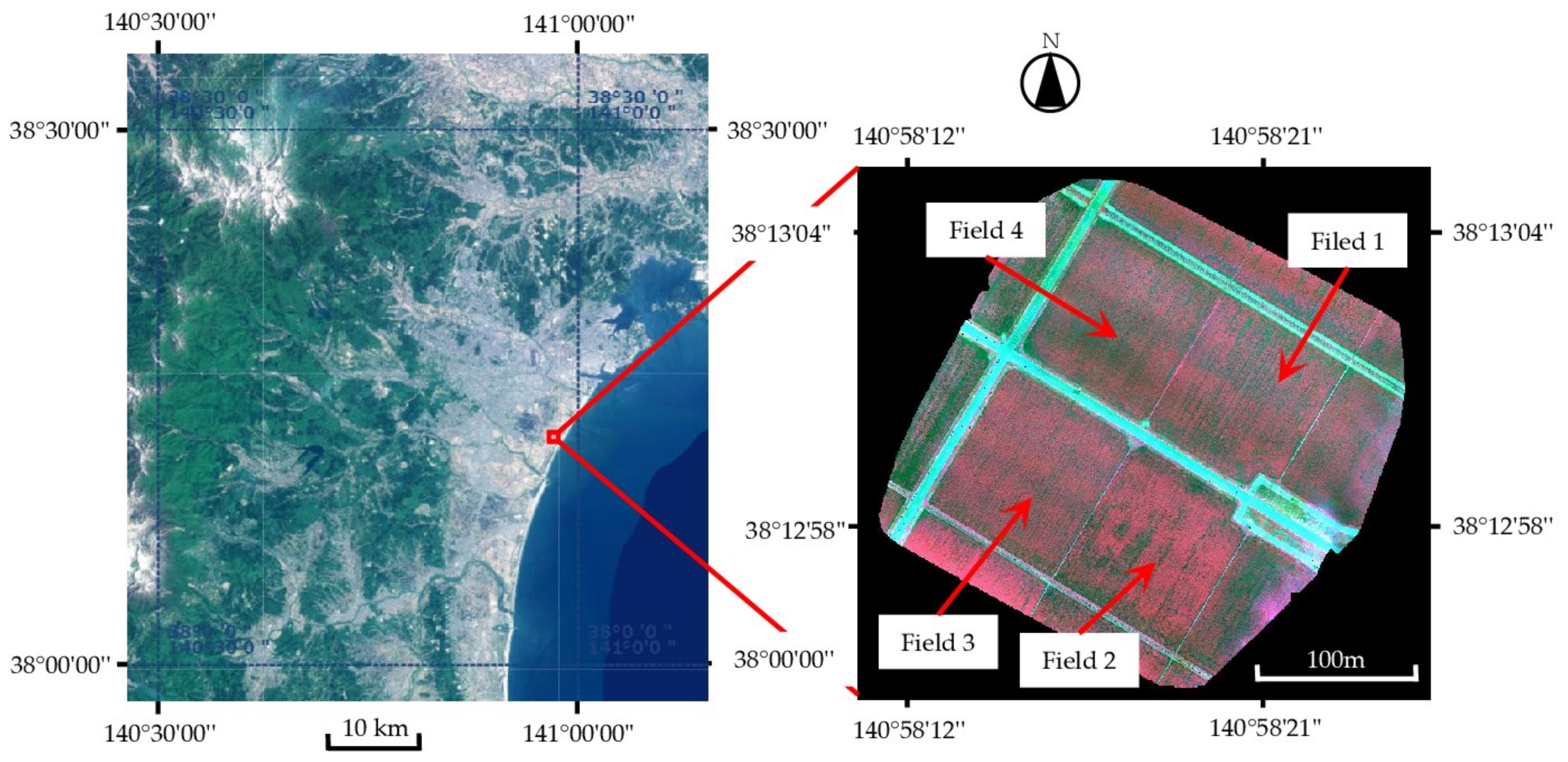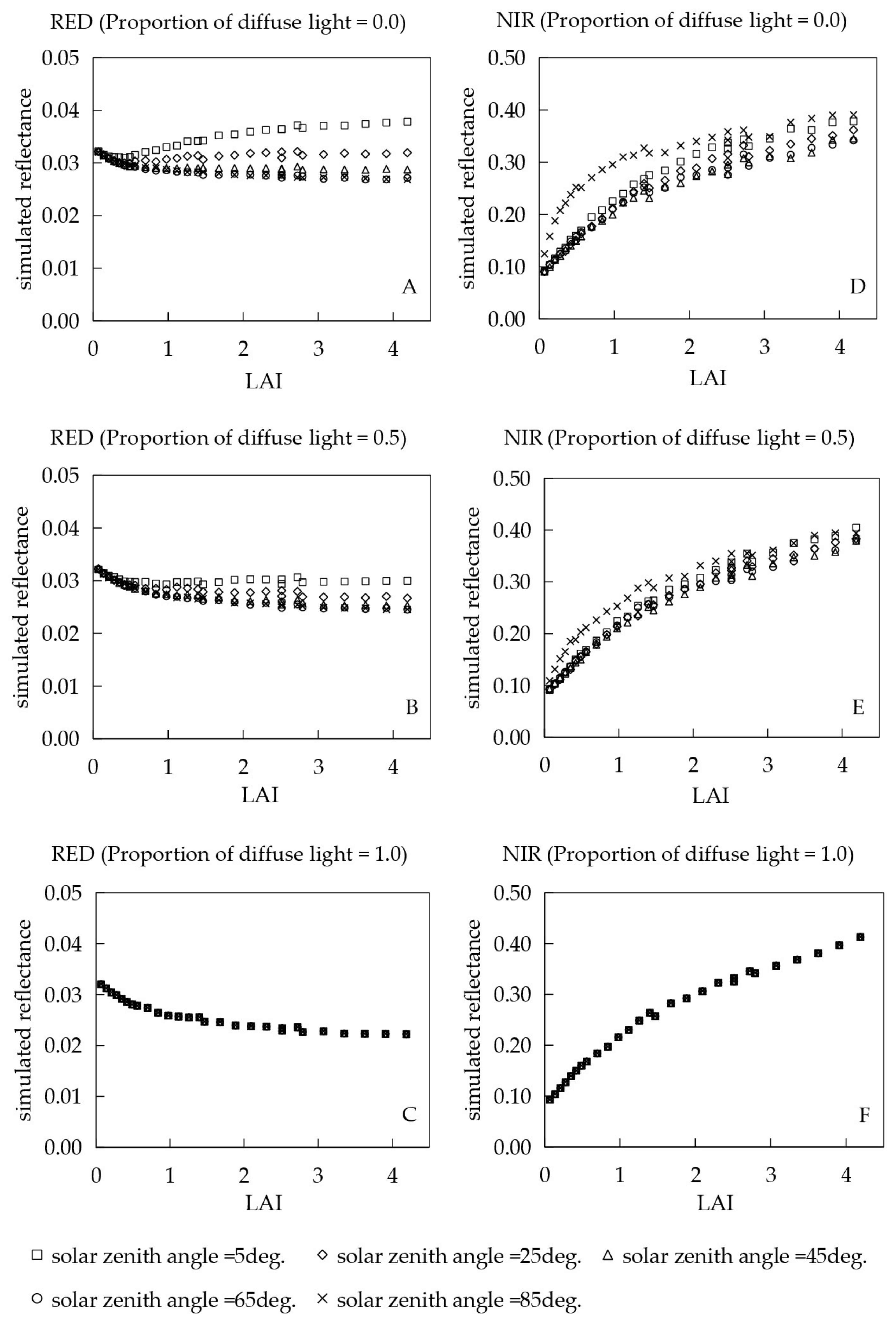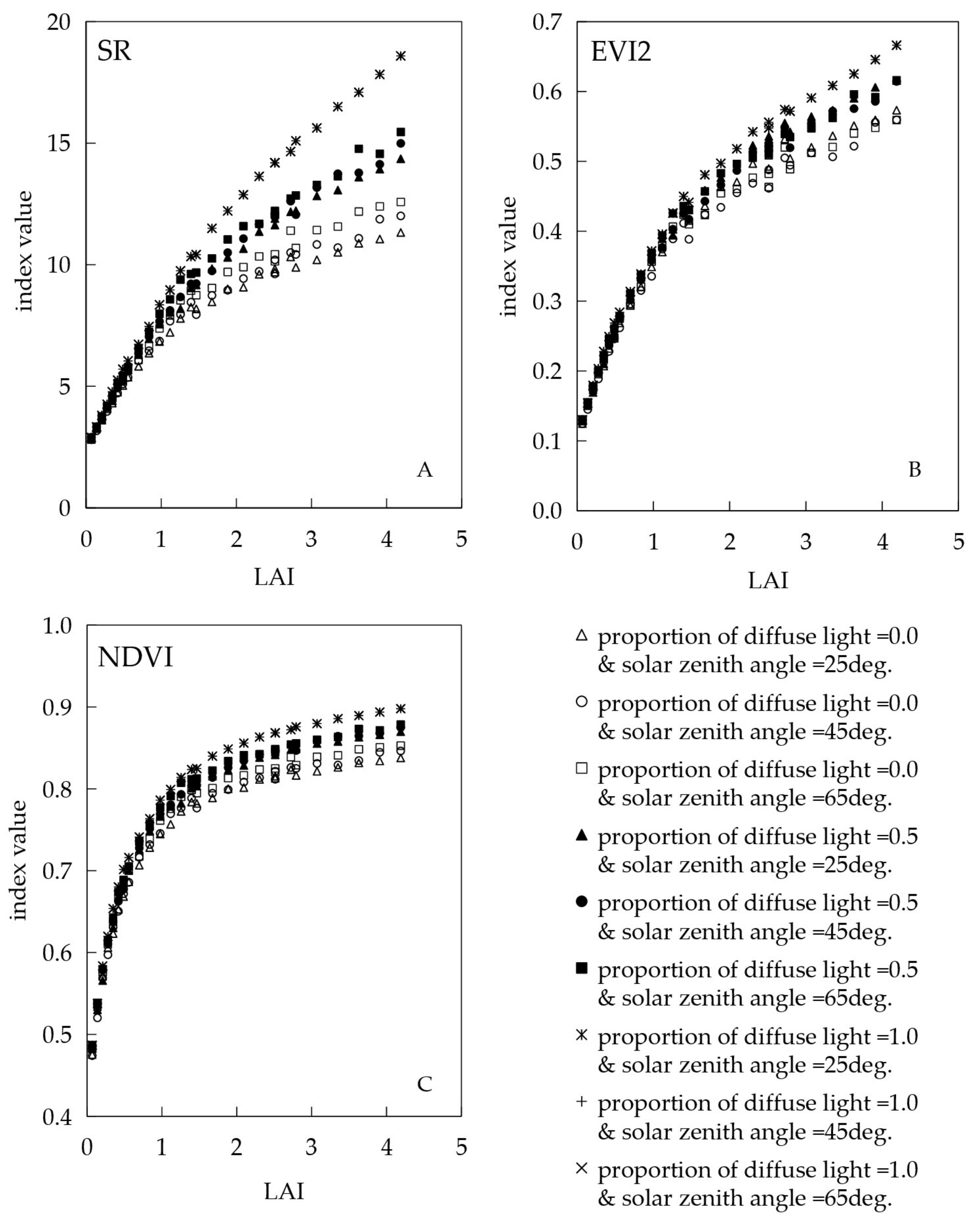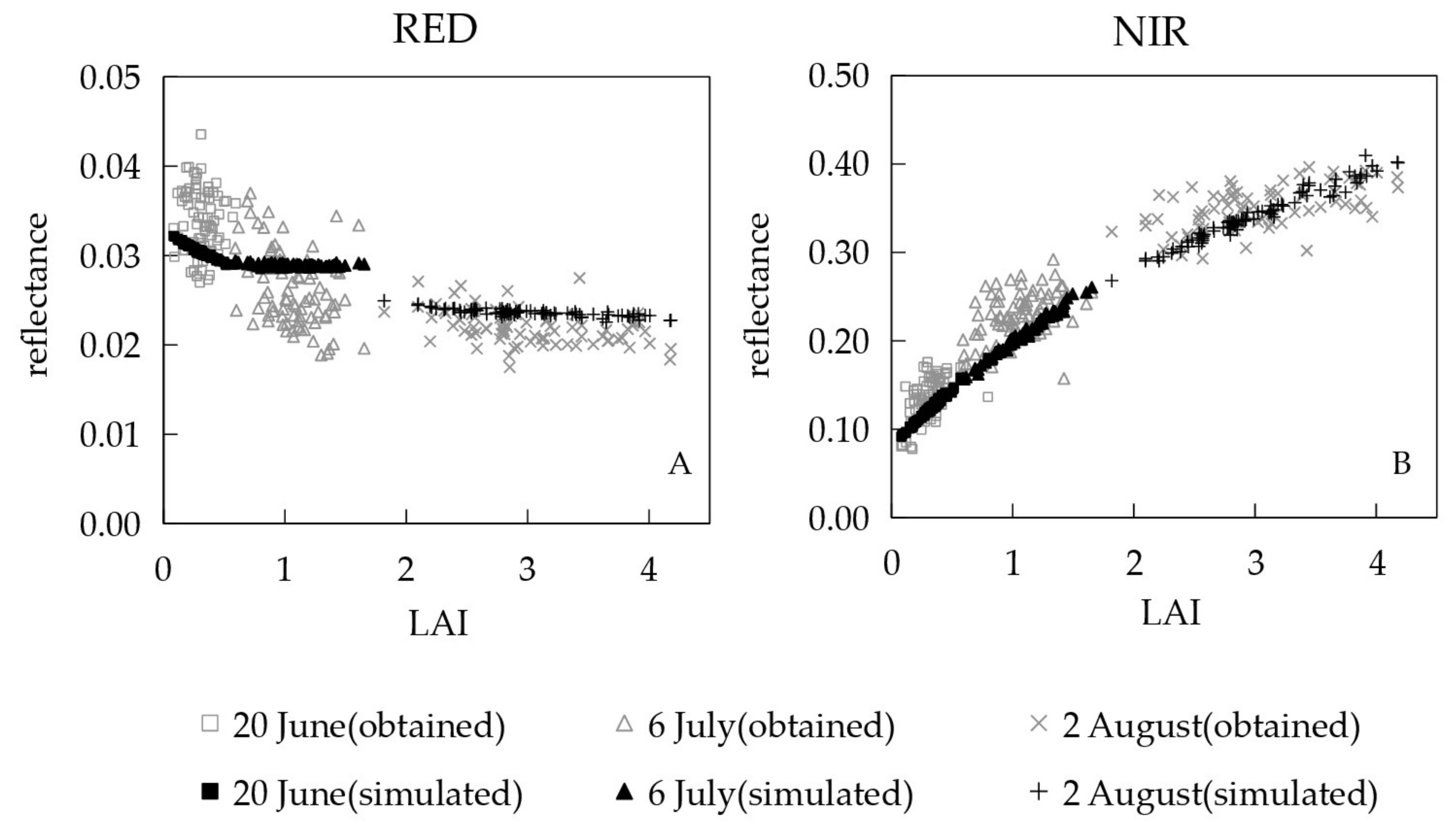Simulation of Reflectance and Vegetation Indices for Unmanned Aerial Vehicle (UAV) Monitoring of Paddy Fields
Abstract
:1. Introduction
2. Materials and Methods
2.1. Simulation of Canopy Reflectance by a Radiative Transfer Model
2.2. Verification of Simulated Reflectance by the Field Measurement
3. Results
3.1. Simulation of Reflectance Values
3.2. Simulation of Vegetation Indices
3.3. Comparison of the Field Measurement Data and the Simulation Results
4. Discussion
5. Conclusions
Author Contributions
Funding
Acknowledgments
Conflicts of Interest
Abbreviations
| EVI2 | Enhanced Vegetation Index 2 |
| FLiES | Forest Light Environmental Simulator |
| LAD | Leaf area density |
| LAI | Leaf area index |
| NDVI | Normalized Difference Vegetation Index |
| NIR | Near-infrared spectral band (770-810 nm) |
| UAV | Unmanned aerial vehicle |
| RED | Red spectral band (640-680 nm) |
| RMSE | Root mean square error |
| SAVI | Soil-Adjusted Vegetation Index |
| SR | Simple Ratio |
References
- Dente, L.; Satalino, G.; Mattia, F.; Rinaldi, M. Assimilation of leaf area index derived from ASAR and MERIS data into CERES-wheat model to map wheat yield. Remote Sens. Environ. 2008, 112, 1395–1407. [Google Scholar] [CrossRef]
- Fang, H.; Liang, S.; Hoogenboom, G.; Teasdale, J.; Cavigelli, M. Corn-yield estimation through assimilation of remotely sensed data into the CSM-CERES-Maize model. Int. J. Remote Sens. 2008, 29, 3011–3032. [Google Scholar] [CrossRef]
- Curnel, Y.; de Wit, A.; Duveiller, G.; Defourny, P. Potential performances of remotely sensed LAI assimilation in WOFOST model based on an OSS experiment. Agric. For. Meteorol. 2011, 151, 1843–1855. [Google Scholar] [CrossRef]
- Padilla, F.L.M.; Maas, S.J.; González-Dugo, M.P.; Mansilla, F.; Rajan, N.; Gavilán, P.; Dominguez, J. Monitoring regional wheat yield in southern Spain using the GRAMI model and satellite imagery. Field Crops Res. 2012, 130, 145–154. [Google Scholar] [CrossRef]
- LAI-2200C Plant Canopy Analyzer LI-COR Environmental. Available online: https://www.licor.com/env/products/leaf_area/LAI-2200C/ (accessed on 11 May 2019).
- Ali, M.; Montzka, C.; Stadler, A.; Menz, G.; Thonfeld, F.; Vereecken, H. Estimation and Validation of RapidEye-Based Time-Series of Leaf Area Index for Winter Wheat in the Rur Catchment (Germany). Remote Sens. 2015, 7, 2808–2831. [Google Scholar] [CrossRef] [Green Version]
- Campos-Taberner, M.; García-Haro, F.J.; Camps-Valls, G.; Grau-Muedra, G.; Nutini, F.; Crema, A.; Boschetti, M. Multitemporal and multiresolution leaf area index retrieval for operational local rice crop monitoring. Remote Sens. Environ. 2016, 187, 102–118. [Google Scholar] [CrossRef]
- Ogawa, S.; Makino, I.; Fukuo, A.; Saito, G. Seasonal Profiles of NDVI for Paddy Fields and their Leaf Area Index Estimates. J. Remote Sens. Soc. Jpn. 2000, 20, 17–26. [Google Scholar]
- Rouse, J.W.; Haas, R.H.; Schell, J.A.; Deering, D.W.; Harlan, J.C. Monitoring the Vernal Advancement and Retrogradation (Green Wave Effect) of Natural Vegetation; Final Report; NASA/GSFC: Greenbelt, MD, USA, 1973; pp. 1–137.
- Huete, A.R. A Soil-Adjusted Vegetation Index (SAVI). Remote Sens. Environ. 1988, 25, 295–309. [Google Scholar] [CrossRef]
- Birth, G.S.; McVey, G.R. Measuring the Color of Growing Turf with a Reflectance Spectrophotometer. Agron. J. 1968, 60, 640–643. [Google Scholar] [CrossRef]
- Huete, A.; Didan, K.; Miura, T.; Rodriguez, E.P.; Gao, X.; Ferreira, L.G. Overview of the radiometric and biophysical performance of the MODIS vegetation indices. Remote Sens. Environ. 2002, 83, 195–213. [Google Scholar] [CrossRef]
- Jiang, Z.; Huete, A.R.; Didan, K.; Miura, T. Development of a two-band enhanced vegetation index without a blue band. Remote Sens. Environ. 2008, 112, 3833–3845. [Google Scholar] [CrossRef]
- Hashimoto, N.; Maki, M.; Tanaka, K.; Tamura, M. Study of a method for extracting LAI time-series patterns for the estimation of crop phenology. J. Remote Sens. Soc. Jpn. 2009, 29, 381–391. [Google Scholar]
- Economic Research Office, ICT Strategy Policy Division, Information and Communications Bureau, Ministry of Internal Affairs and Communications, Japan. Information and Communications in Japan White Paper 2018; Ministry of Internal Affairs and Communications, Japan: Tokyo, Japan, 2018; p. 15.
- Yu, N.; Li, L.; Schmitz, N.; Tian, L.F.; Greenberg, J.A.; Diers, B.W. Development of methods to improve soybean yield estimation and predict plant maturity with an unmanned aerial vehicle based platform. Remote Sens. Environ. 2016, 187, 91–101. [Google Scholar] [CrossRef]
- Hassan, M.A.; Yang, M.; Rasheed, A.; Jin, X.; Xia, X.; Xiao, Y.; He, Z. Time-Series multi-spectral Indices from Unmanned Aerial Vehicle Imagery Reveal Senescence Rate in Bred Wheat. Remote Sens. 2018, 10, 809. [Google Scholar] [CrossRef]
- Jin, X.; Liu, S.; Baret, F.; Hemerlé, M.; Comar, A. Estimates of plant density of wheat crops at emergence from very low altitude UAV imagery. Remote Sens. Environ. 2017, 198, 105–114. [Google Scholar] [CrossRef] [Green Version]
- Mukoyama, S.; Kosugi, Y.; Uto, K.; Saito, G.; Oda, K. SPAD value estimation of paddy leaves using a hyperspectral sensor mounted on a radio-controlled helicopter. J. Jpn. Soc. Photogram. Remote Sens. 2011, 50, 90–95. [Google Scholar] [CrossRef] [Green Version]
- Zhou, X.; Zheng, H.B.; Xu, X.Q.; He, J.Y.; Ge, X.K.; Yao, X.; Cheng, T.; Zhu, Y.; Cao, W.X.; Tian, Y.C. Predicting grain yield in rice using multi-temporal vegetation indices from UAV-based multi-spectral and digital imgery. ISPRS J. Photogramm. Remote Sens. 2017, 130, 246–255. [Google Scholar] [CrossRef]
- Maki, M.; Homma, K.; Oki, K. Estimation of Leaf Area Index (LAI) Using Crop Model with UAV Imagery and Potential of Geospatial Expansion of Its Method. Water Land Environ. Eng. 2016, 84, 757–760. [Google Scholar]
- Kobayashi, H.; Iwabuchi, H. A coupled 1-D atmosphere and 3-D canopy radiative transfer model for canopy reflectance, light environment, and photosynthesis simulation in a heterogeneous landscape. Remote Sens. Environ. 2008, 112, 173–185. [Google Scholar] [CrossRef]
- Borgogno-Mondino, E.; Lessio, A.; Gomarasca, M.A. A fast operative method for NDVI uncertainty estimation and its role in vegetation analysis. Eur. J. Remote Sens. 2016, 49, 137–156. [Google Scholar] [CrossRef]
- Kobayashi, H.; Baldocchi, D.D.; Ryu, Y.; Chen, Q.; Ma, S.; Osuna, J.L.; Ustin, S.L. Modeling energy and carbon fluxes in a heterogeneous oak woodland: A three-dimensional approach. Agric. For. Meteorol. 2012, 152, 83–100. [Google Scholar] [CrossRef] [Green Version]
- Kobayashi, H.; Ryu, Y.; Baldocchi, D.D.; Welles, J.M.; Norman, J.M. On the correct estimation of gap fraction: How to remove scattered radiation in gap fraction measurements? Agric. For. Meteorol. 2013, 174–175, 170–183. [Google Scholar] [CrossRef]
- Oshio, H.; Asawa, T.; Hoyano, A.; Miyasaka, S. Quantification of Solar Shading Effect of Urban Trees Using Multi-Return Airborne LiDAR Data and a Radiative Transfer Model of Vegetation. J. Remote Sens. Soc. Jpn. 2015, 35, 10–23. [Google Scholar]
- Kobayashi, H. Relationship between Spectral Reflectance and Leaf Area Index in Needleleaf Forest: The Effect of Three-Dimensional Forest Structure and Clumping. J. Remote Sens. Soc. Jpn. 2008, 28, 350–356. [Google Scholar]
- Maki, M.; Takahashi, A.; Okano, T.; Oguma, H. Development of the Method to Estimate Light Environment on Forest Floor Using 3D Portable Laser Scanner and Radiative Transfer Model. J. Remote Sens. Soc. Jpn. 2012, 32, 77–87. [Google Scholar]
- Ichii, K.; Yang, W.; Kobayashi, H.; Yanagi, Y.; Takayama, H.; Hajima, T.; Abe, M.; Tachiiri, K. Development and application of GCOM-C LAI and GPP/NPP research products. In Proceedings of the 2017 IEEE International Geoscience and Remote Sensing Symposium (IGARSS), Fort Worth, TX, USA, 23–28 July 2017; IEEE: Piscataway, NJ, USA, 2017; pp. 550–5651. [Google Scholar]
- Maki, M.; Homma, K. Empirical Regression Models for Estimating Multiyear Leaf Area Index of Rice from Several Vegetation Indices at the Field Scale. Remote Sens. 2014, 6, 4764–4779. [Google Scholar] [CrossRef] [Green Version]
- GSI HOME PAGE. Available online: http://www.gsi.go.jp/ (accessed on 11 May 2019).
- Pix4D Support. Available online: https://support.pix4d.com/hc/en-us (accessed on 11 May 2019).
- Sango, K. Digital Japan Basic Map (Ortho Image). J. Geogr. Surv. Inst. 2009, 118, 57–60. (In Japanese) [Google Scholar]
- Erbs, D.G.; Klein, S.A.; Duffie, J.A. Estimation of the diffuse radiation fraction for hourly, daily and monthly-average global radiation. Solar Energy 1982, 28, 293–302. [Google Scholar] [CrossRef]
- Japan Meteorological Agency. Available online: https://www.jma.go.jp/jma/index.html (accessed on 12 March 2019).
- Hirooka, Y.; Homma, K.; Shiraiwa, T.; Kuwada, M. Parameterization of leaf growth in rice (Oryza sativa L.) utilizing a plant canopy analyzer. Field Crops Res. 2016, 186, 117–123. [Google Scholar] [CrossRef]




| Category | Parameters | Contents | Note |
|---|---|---|---|
| Solar radiation condition | Proportion of diffuse light | 0, 0.5, 1 | Range is from 0 to 1 |
| Solar zenith angle (degrees) | 5, 25, 45, 65, 85 | Range is from 0 to 90 | |
| Canopy structure | Leaf reflectance | RED: 0.05973 NIR: 0.40321 | Measured in the paddy field of Kyoto University in 2009. |
| Leaf transmittance | RED: 0.01746 NIR: 0.54573 | ||
| Soil reflectance | RED: 0.03306 NIR: 0.08060 | ||
| Leaf area density (LAD) (m2 m-3) | 0, 1, 2, 3, 4, 5, 6, 7, 8, 9, 10, 11, 12, 13, 14, 15 | ||
| Plant height (m) | 0.2, 0.4, 0.6, 0.8 | ||
| Coordinate (m) | Distance between rows:0.3 Distance of hill interval in a row:0.2 | Based on the measured fields |
| Date | RED | NIR | ||||
|---|---|---|---|---|---|---|
| Average | RMSE | Average | RMSE | |||
| Obtained | Simulated | Obtained | Simulated | |||
| 20 June | 0.034 (0.004) | 0.030 (0.001) | 0.006 | 0.137 (0.023) | 0.123 (0.015) | 0.023 |
| 6 July | 0.026 (0.004) | 0.029 (0.000) | 0.005 | 0.230 (0.026) | 0.205 (0.024) | 0.037 |
| 2 August | 0.022 (0.002) | 0.024 (0.000) | 0.002 | 0.349 (0.024) | 0.342 (0.031) | 0.028 |
| Date | SR | EVI2 | NDVI | ||||||
|---|---|---|---|---|---|---|---|---|---|
| Average | RMSE | Average | RMSE | Average | RMSE | ||||
| Obtained | Simulated | Obtained | Simulated | Obtained | Simulated | ||||
| 20 June | 4.039 (0.745) | 4.066 (0.603) | 0.719 | 0.209 (0.043) | 0.193 (0.031) | 0.040 | 0.593 (0.067) | 0.600 (0.047) | 0.059 |
| 6 July | 9.041 (1.902) | 7.096 (0.845) | 2.532 | 0.394 (0.045) | 0.345 (0.041) | 0.065 | 0.794 (0.039) | 0.750 (0.027) | 0.055 |
| 2 August | 16.010 (2.080) | 14.482 (1.513) | 2.319 | 0.583 (0.036) | 0.568 (0.043) | 0.040 | 0.881 (0.016) | 0.870 (0.013) | 0.018 |
© 2019 by the authors. Licensee MDPI, Basel, Switzerland. This article is an open access article distributed under the terms and conditions of the Creative Commons Attribution (CC BY) license (http://creativecommons.org/licenses/by/4.0/).
Share and Cite
Hashimoto, N.; Saito, Y.; Maki, M.; Homma, K. Simulation of Reflectance and Vegetation Indices for Unmanned Aerial Vehicle (UAV) Monitoring of Paddy Fields. Remote Sens. 2019, 11, 2119. https://doi.org/10.3390/rs11182119
Hashimoto N, Saito Y, Maki M, Homma K. Simulation of Reflectance and Vegetation Indices for Unmanned Aerial Vehicle (UAV) Monitoring of Paddy Fields. Remote Sensing. 2019; 11(18):2119. https://doi.org/10.3390/rs11182119
Chicago/Turabian StyleHashimoto, Naoyuki, Yuki Saito, Masayasu Maki, and Koki Homma. 2019. "Simulation of Reflectance and Vegetation Indices for Unmanned Aerial Vehicle (UAV) Monitoring of Paddy Fields" Remote Sensing 11, no. 18: 2119. https://doi.org/10.3390/rs11182119
APA StyleHashimoto, N., Saito, Y., Maki, M., & Homma, K. (2019). Simulation of Reflectance and Vegetation Indices for Unmanned Aerial Vehicle (UAV) Monitoring of Paddy Fields. Remote Sensing, 11(18), 2119. https://doi.org/10.3390/rs11182119








